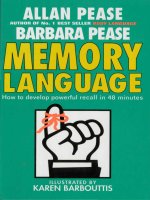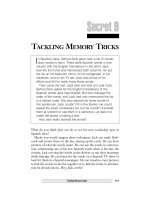TACKLING MEMORY TRICKS
Bạn đang xem bản rút gọn của tài liệu. Xem và tải ngay bản đầy đủ của tài liệu tại đây (106.11 KB, 16 trang )
What do you think Jack can do to ace his next vocabulary quiz in
Spanish class?
Maybe you would suggest these techniques: Jack can make flash-
cards and review them on the bus, mixing up the cards. He can draw
pictures of what the words mean. He can use the words in conversa-
tion, substituting one of his new Spanish words when it fits into the
context. Jack can sing the words in the shower or rap their meanings
while dancing. He can listen for the words on a Spanish TV show or
look for them in a Spanish newspaper. He can visualize crazy pictures
to link the words on the list together or to link the terms to informa-
tion he already knows. Hey, Jack, arriba!
Tackling Memory Tricks
117
Secret 9
T
ACKLING
M
EMORY
T
RICKS
I
n Spanish class, Señora Solis gave Jack a list of vocab-
ulary words to learn. There were Spanish words in one
column with the English translations in the other. Jack
took the list home and memorized both columns. He put
the list on his bedroom mirror, on his refrigerator, in his
notebook, and on his TV set. Jack was proud of his
efforts and felt he really knew those words.
Then came the test. Jack took one look at it and froze.
Señora Solis asked for the English translations of the
Spanish words Jack had studied. But she changed the
order of the words, and Jack had only memorized the list
in a certain order. She also asked how some words fit
into sentences. Jack couldn’t fill in the blanks. He could
repeat the exact vocabulary list, but he couldn’t translate
them at random or use them in a sentence—at least not
under the stress of taking a test.
Has Jack really learned the words?
MEMORIZING AND REMEMBERING
You are studying a lecture or a textbook chapter. You understand it—
and now you want it to stick! How do you make sure you won’t for-
get it by tomorrow? The trick is to start by identifying what is
important to you and relating it to something you know. Use it in
your conversations, write it down, draw it, or record it. Get actively
involved with the new material, using your preferred learning style
(see Secret #5).
Although most students memorize a great deal before a quiz
or test, the truth is that straight memorizing is the least effective way
to remember anything. Better ways to remember facts and formu-
las are:
1. associating them with something you already know
2.
applying multiple senses: hearing, seeing, smelling, touching, speaking
3. drawing or diagramming
4. using mnemonic devices—memory tricks—such as acronyms and
acrostics
5. visualizing with methods such as place, peg, and linking
You should know that there is a difference between memorizing
something and remembering it. Straight memorization doesn’t usu-
ally stay with you very long. Real learning, on the other hand, lets
you remember and apply what you learned. Because you use it, it has
meaning for you. Because it has meaning for you, you are apt to
remember it.
SHORT-TERM AND LONG-TERM
MEMORY
There are basically two different kinds of memory, short-term and
long-term. To better understand the difference, think of your brain
as a parking facility. One part of it specializes in “parking” new infor-
mation for only a few days, in short-term parking. If the new infor-
mation is reinforced in some way, it gets shifted to long-term parking.
Attaching new information to an emotion or to another long-term
memory are two ways to store new information permanently in this
long-term lot. (Researchers believe that most of us can keep between
118
10 SECRETS TO ACING ANY HIGH SCHOOL TEST
five and nine items at one time in our short-term memories, but we
can store an infinite number of items in our long-term memories.)
Let’s say you are studying in a chair at the library, reading about
cumulus clouds. The girl sitting next to you smells like violets, just
like your grandmother, whom you miss terribly. You are likely to
remember more about cumulus clouds (even the layout of the page
the text was on) because of the emotional attachment your nose and
your brain just made. It’s true!
As a student, you may learn something at the beginning of the
semester that you want to retain for the final exam. For this reason,
you will need to move it from short-term memory to long-term mem-
ory. You subconsciously do this all the time, especially with something
you have an emotional attachment to, such as the memory of picking
out your first puppy at the pound.
On the other hand, some things belong in short-term memory—they
would just clutter up the long-term side. For instance, you learn the Rialto
Movie Palace’s phone number just long enough to dial up the recording of
show times, and then your short-term memory disposes of it.
So, how do you turn short-term memorization into long-term
remembering? With the secrets of mnemonics—that’s how.
WHAT ARE MNEMONICS ANYWAY?
As a child, did you chant “i before e, except after c”? Do you still? If
so, you will probably never forget how to spell “brief” or “receive.”
Mnemonics are memory tricks that can help us to remember what we
need to know. Rhyming, such as “i before e, except after c,” is one kind
of mnemonic device. This chapter highlights several specific
mnemonic devices so you can:
•
file and retrieve important information for upcoming exams
•
apply what you learn to how you live
•
enjoy learning for its own satisfaction and share it with others
Besides rhymes and songs, two popular mnemonic devices that you may
have already tried are acronyms and acrostics. Other memory secrets
include chunking and visualization techniques such as the place and peg
methods and linking. All of these memory devices are designed to help
you store, retain, and recall information.
Now, let’s take a closer look at some mnemonic tricks.
Tackling Memory Tricks
119
ACRONYMS
Acronyms are formed by using the first letter from a group of words
to form a new word. This is particularly useful when remembering
words in a specified order. Acronyms are very common in ordinary
language and in many fields. Examples include SCUBA (Self Con-
tained Underwater Breathing Apparatus) and LASER (Light Ampli-
fication by Stimulated Emission of Radiation). What other common
acronyms can you think of?
Your geography teacher wants you to learn the names of the Great
Lakes. You might make the acronym HOMES, which is a word
formed by the first letter from each of the names of the Great Lakes:
Huron
Ontario
Michigan
Erie
Superior
“Homes” is a real word; however, you can also make up a nonsense
word to help you remember a list. A common acronym for reviewing
the colors of the visible spectrum is the silly word “roygbiv.” You can
turn this into an imaginary person’s name, “Roy G. Biv,” if that helps
you remember the letters.
Red
Orange
Yellow
Green
Blue
Indigo
Violet
Note: In this case—and in contrast with the Great Lakes example—
the order of the items to be remembered (colors) is essential because
this is their order in the spectrum.
Now, consider the acronym NIMBY, often heard in city council
and planning board meetings. NIMBY refers to people who protest
the construction of, say, a power plant in their neighborhood. This
120
10 SECRETS TO ACING ANY HIGH SCHOOL TEST
acronym stands for an entire phrase: “Not In My Back Yard!” As you
can see, some acronyms stand for words or phrases that have to be in
a certain order, and some do not.
An interesting twist on acronyms is one named for a real person,
Dr. Virginia Apgar, the American anesthesiologist who designed the
index for rating newborn babies. Healthcare professionals often
remember the assessment for newborns this way:
Appearance (color)
Pulse
Grimace (response to stimuli)
Activity (muscle tone)
Respiration
Although acronyms can be very useful memory aids, they do have
some disadvantages. First, they are useful for rote memory but do not
aid comprehension. Be sure to differentiate between comprehension
and memory, keeping in mind that understanding is often the best way
to remember. Some people assume that if they can remember some-
thing, they must “know” it, but as we saw in Jack’s case, memorization
does not necessarily lead to understanding.
A second problem with acronyms is that they can be difficult to
form; not all lists of words will lend themselves equally well to this
technique. Finally, acronyms, like everything else, can be forgotten if
not committed to memory.
Creating Acronyms
Since you can create an acronym for just about anything you want
to remember, you can use acronyms to help you recall the material
you are studying for just about any quiz or test. Even though it
will take you a few minutes to create an acronym, the extra effort
pays off during exam time when you are able to retrieve crucial
information.
Follow these steps to create your own acronyms:
1. Choose a particular list of terms you want to memorize or a num-
ber of steps in a process you want to be able to recall.
2. Write down those terms or steps on a sheet of paper.
Tackling Memory Tricks
121
3. If the order of the terms or steps is not essential, consider rear-
ranging the terms.
4. Be creative in finding one or more words that consist of the first
letters of the terms or steps in your list.
5. Pick the acronym from your brainstorming that you are most likely
to remember based on your own experience, memory, and knowl-
edge. CLUE: Link what you know to what you need to remember.
6. Arrange the terms you want to recall in the order of your chosen
acronym. Highlight or underscore the first letter of each term so
when you review, it will be easier to see the acronym.
Once you invest the time in creating acronyms, review them often.
You can rewrite them or read them aloud. Study your acronyms over
and over until they become familiar friends. The same may be said for
acrostics.
ACROSTICS
Another type of mnemonic is a silly sentence or phrase, known as an
acrostic, which is made of words that each begin with the letter or
letters that start each item in a series you want to remember. For
example, “Please Excuse My Dear Aunt Sally” is a nonsensical acros-
tic that math students use to remember the order of operations:
Please Excuse My Dear Aunt Sally ϭ
Parentheses, Exponents, Multiply, Divide, Add, Subtract
Here’s another example of an acrostic. To remember the letters of
the notes on the lines of the treble clef (E, G, B, D, and F), music stu-
dents often recite this acrostic: Every Good Boy Does Fine. (The
notes on the spaces between the lines form the acronym FACE for the
musical notes F, A, C, and E.) Can you think of other examples?
Like acronyms, acrostics can be very simple to remember and are
particularly helpful when you need to remember a list in a specific
order. One advantage of acrostics over acronyms is that they are less
limiting; if your words don’t form easy-to-remember acronyms, using
acrostics may be preferable. On the other hand, they can take more
thought to create and require remembering a whole new sentence
rather than just one word. Otherwise, they present the same problem
as acronyms in that they aid memorization but not comprehension.
122
10 SECRETS TO ACING ANY HIGH SCHOOL TEST









